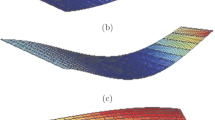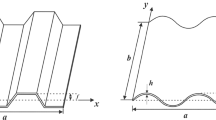The differential quadrature method is extended to deal with an aeroelastic problem. A structural model is presented based on Hamilton’s principle, and the piston theory is used for modeling supersonic aerodynamic loads. A solution for the flutter of a composite wing skin is obtained by using the differential quadrature method. The validity of this method is confirmed by comparing its results with FEM solutions for the natural frequencies and flutter speed. Then, a detailed parametric study is carried out to examine the influence of the thickness, area, ply-angle, and aspect ratio of composite wings skins on their supersonic flutter behavior. It is shown that the flutter speed of a composite wing skin strongly depends on the area, thickness, ply angle, and aspect ratio of the structure.









Similar content being viewed by others
References
X. Zhao Lie, “Vibration analysis of laminated composite cylindrical panels via a mesh free approach,” Int. J. of Solids and Structures, 40, 161-80, (2003).
M. K. Singha, L. S. Ramachandra, and J. N. Bandyopadhyay, “Nonlinear response of laminated cylindrical shell panels subjected to thermo-mechanical loads,” J. of Engineering Mechanics-ASCE, 132, 1088-1095, (2006).
Oh Il-Kwon, “Vibration characteristics and supersonic flutter of cylindrical composite panels with large thermoelastic deflections,” Composite Structures, 90, 208–216, (2009).
M. K. Singha and M. Mandal, “Supersonic flutter characteristics of composite cylindrical panels,” Composite Structures, 82, 295-301 (2008).
A. Suleman, “Adaptive composites modeling and application in panel flutter and noise suppression,” Computers and Structures, 76, 365-378, (2000).
R. M. V. Pidaparti and H. T. Y. Yang, “Supersonic flutter analysis of composite plates and shells,” AIAA J, 31, No. 6, 1109-1117. (1993).
G. W. Barr and R. O. Stearman, “Aeroelastic stability characteristics of cylindrical shells considering imperfections and edge constraint,” AIAA J, 7, No. 8, 912-919, (1969).
Jang Sung Kuk, Application of Differential Quadrature to the Analysis of Structural Components, The University of Oklahoma. (1987).
Moinuddin Malik, Differential Quadrature Method in Computational Mechanics: New Developments and Applications. The University of Oklahoma. (1994).
Zahid Ahmad Siddiqi, Analysis of Interacting Sub-Domains in Structural Mechanics Problems by the Differential Quadrature Method. The University of Oklahoma (1996).
R. Bellman and J. Casti, “Differential quadrature and long-lerm integration,” J. of Math. Analysis and Application, 34, 235-238, (1971)
C. W. Bert, S. K. Jang, and A. G. Striz, “Two new approximate methods for analyzing free vibration of structural components,” American Institute of Aeronautics and Astronautics J., 26, 612-618, (1988).
A. G. Striz, S. K. Jang, and C. W. Bert, “Nonlinear bending analysis of thin circular plates by differential quadrature,” Thin-Walled Structures, 6, 51-62. (1988).
S. K. Jang, C. W. Bert, and A. G. Striz, “Application of differential quadrature to static analysis of structural components,” Int. J. for Numerical Methods in Engineering, 28, 561-577, (1989).
A. N. Sherbourne and M. D. Pandey, “Differential quadrature method in the buckling analysis of beams and composite plates,” Computers and Structures, 40, 903-913, (1991).
C. Shu and B. E. Richards, “Application of generalized differential quadrature to solve two-dimensional incompressible Navier-Stokes equations,” Int. J. for Numerical Methods in Fluids, 15, 791-798, (1992).
R. H. Gutierrez and P. A. A. Laura, “Solution of the Helmholtz equation in a parallelogrammic domain with mixed boundary conditions using the differential quadrature method,” J. of Sound and Vibration, 178, 269-271, (1994).
M. Malik and C. W. Bert, “Three-dimensional elasticity solutions for free vibrations of rectangular plates by the differential quadrature method,” Int. J. of Solids and Structures, 35, 299-318, (1998).
G. R.Liu and T. Y. Wu, “Multipoint boundary value problems by differential quadrature method,” Mathematical and Computer Modeling, 35, 215-227, (2002).
Francesco Tornabene, “Free vibration of laminated composite doubly-curved shells and panels of revolution via the GDQ method,” Computer Methods in Applied Mechanics and Engineering, 10, 1-49, (2010).
S. C. Pradhan and A. Kumar, “Vibration analysis of orthotropic grapheme sheets embedded in Pasternak elastic medium using nonlocal elasticity theory and differential quadrature method,” Computational Materials Science, 50, 239-245, (2010).
G. Karami and P. Malekzadeh, “A new differential quadrature methodology for beam analysis and the associated differential quadrature element method,” Computer Methods in Applied Mechanics and Engineering, 10, 3509-3526, (2002).
Hans Krumhaar, “The accuracy of linear piston theory when applied to cylindrical shells,” AIAA J, 1, No. 6, 14481449 (1963).
Acknowledgments
The authors are grateful for the support from the graduate student scientific innovation foundation of the National University of Defense Technology (No. B120107).
Author information
Authors and Affiliations
Corresponding author
Additional information
Russian translation published in Mekhanika Kompozitnykh Materialov, Vol. 48, No. 5, pp. 793-806 , September-October, 2012.
Rights and permissions
About this article
Cite this article
Niu, Y., Wang, Z. & Zhang, W. Flutter Analysis of a supersonic composite AirFoil skin by using the Differential Quadrature Method. Mech Compos Mater 48, 547–558 (2012). https://doi.org/10.1007/s11029-012-9299-x
Received:
Revised:
Published:
Issue Date:
DOI: https://doi.org/10.1007/s11029-012-9299-x




